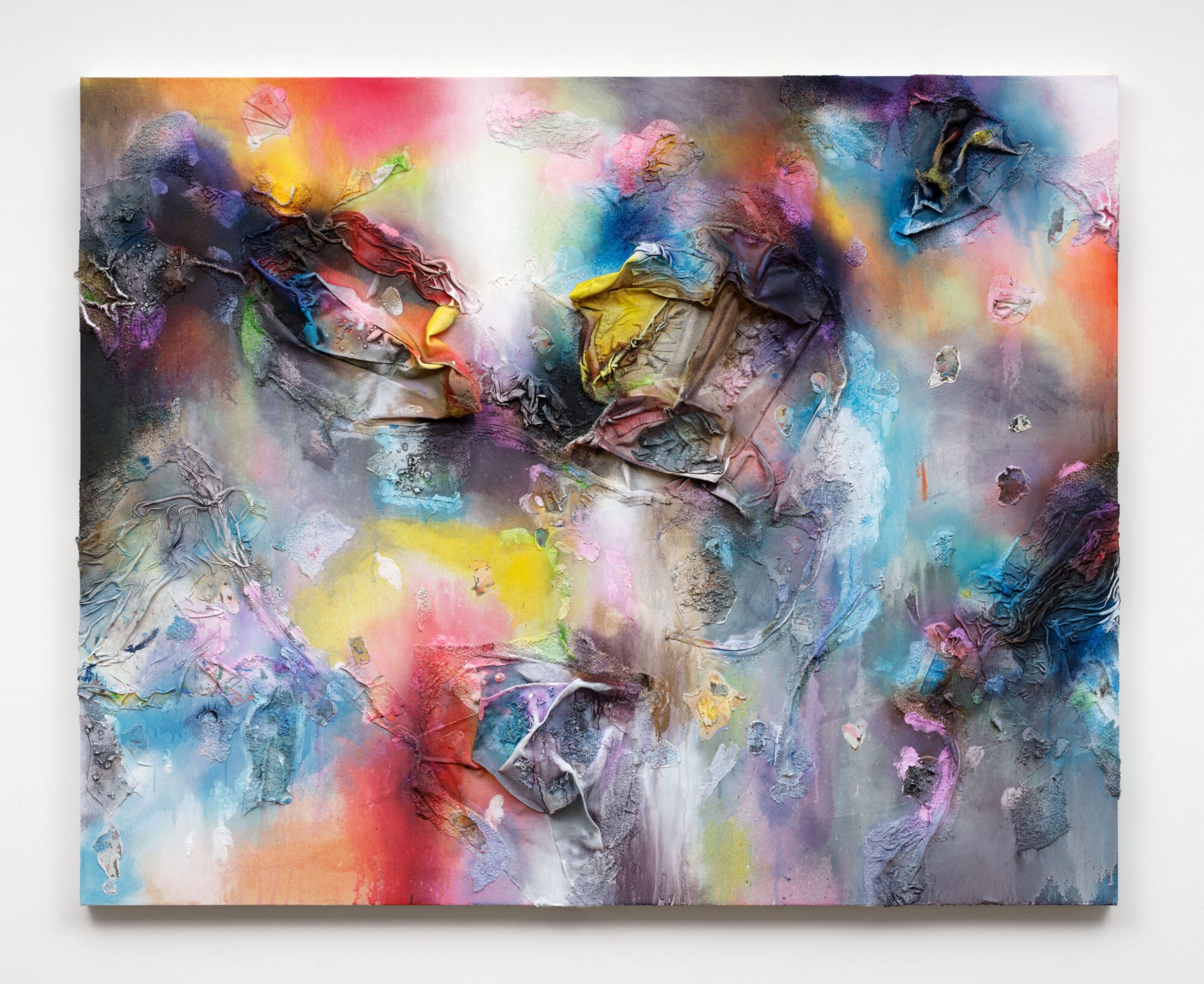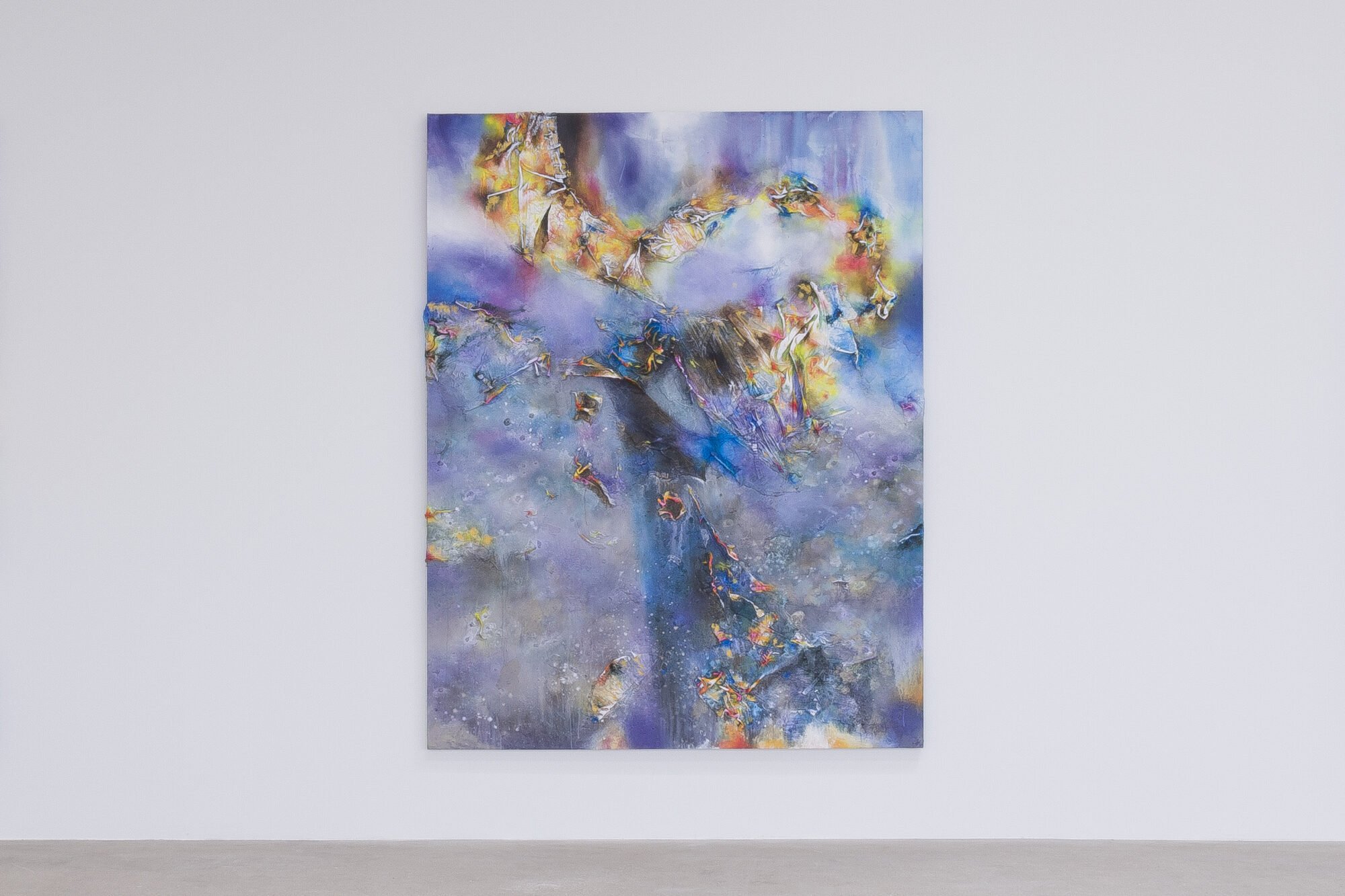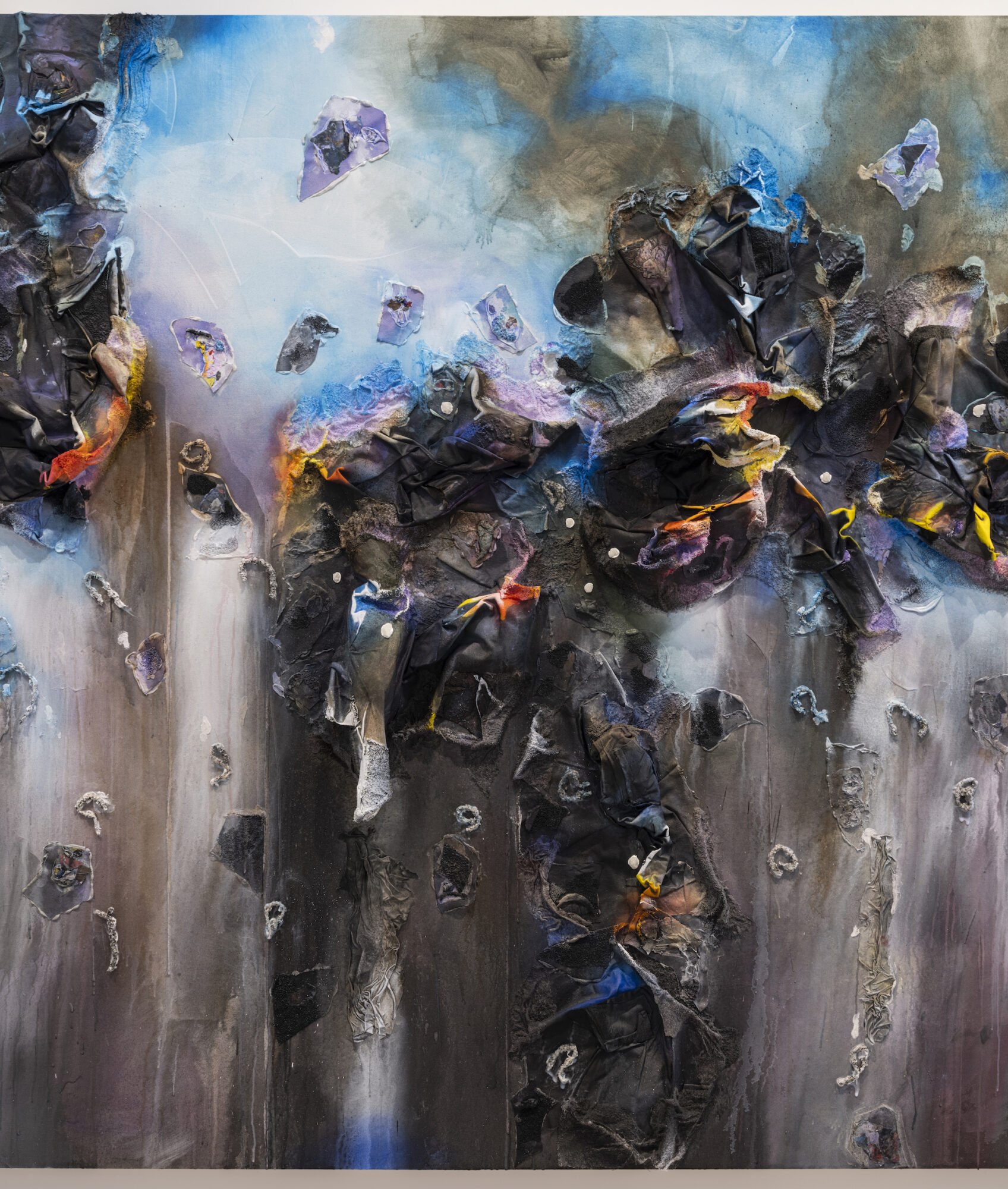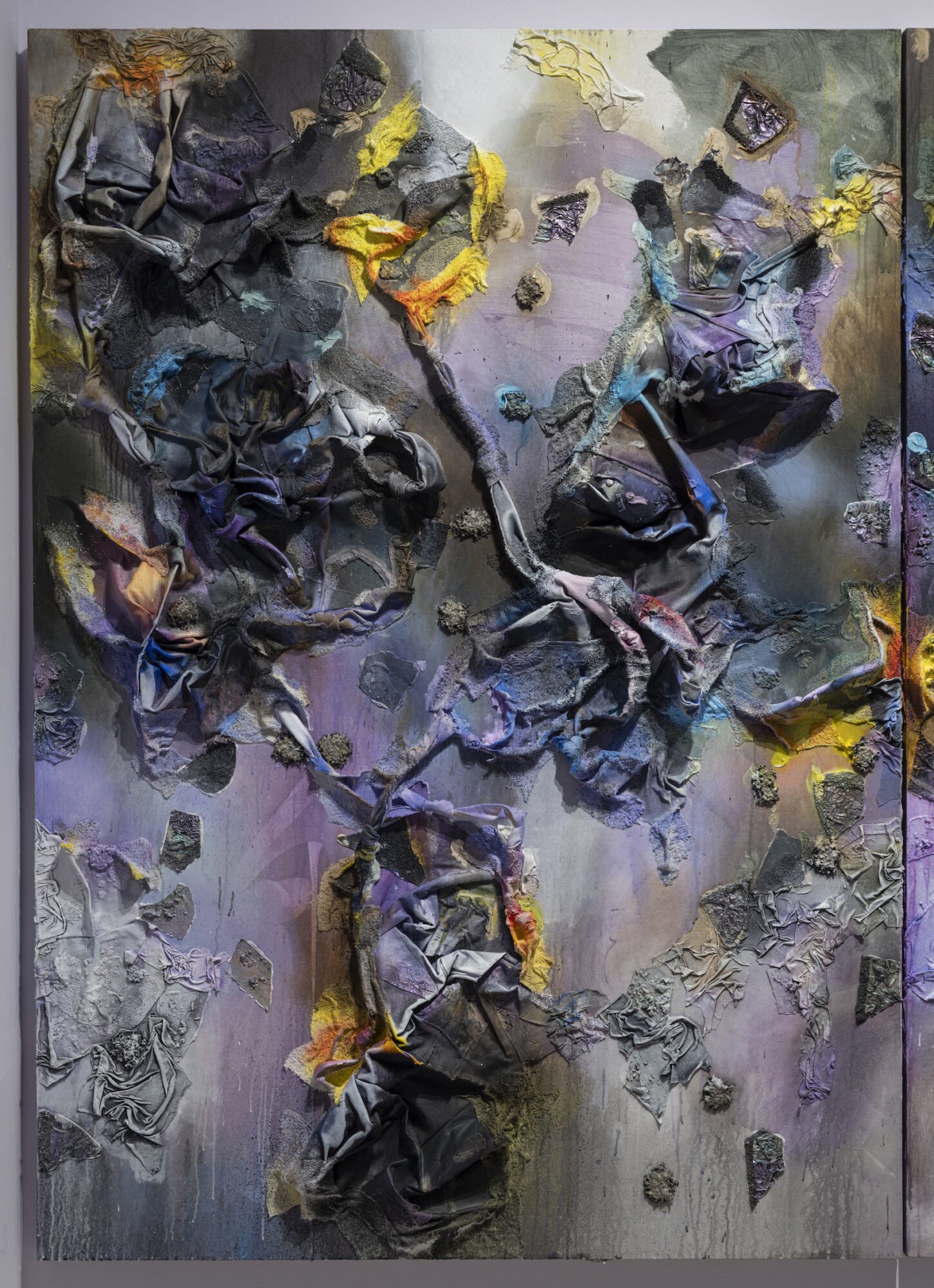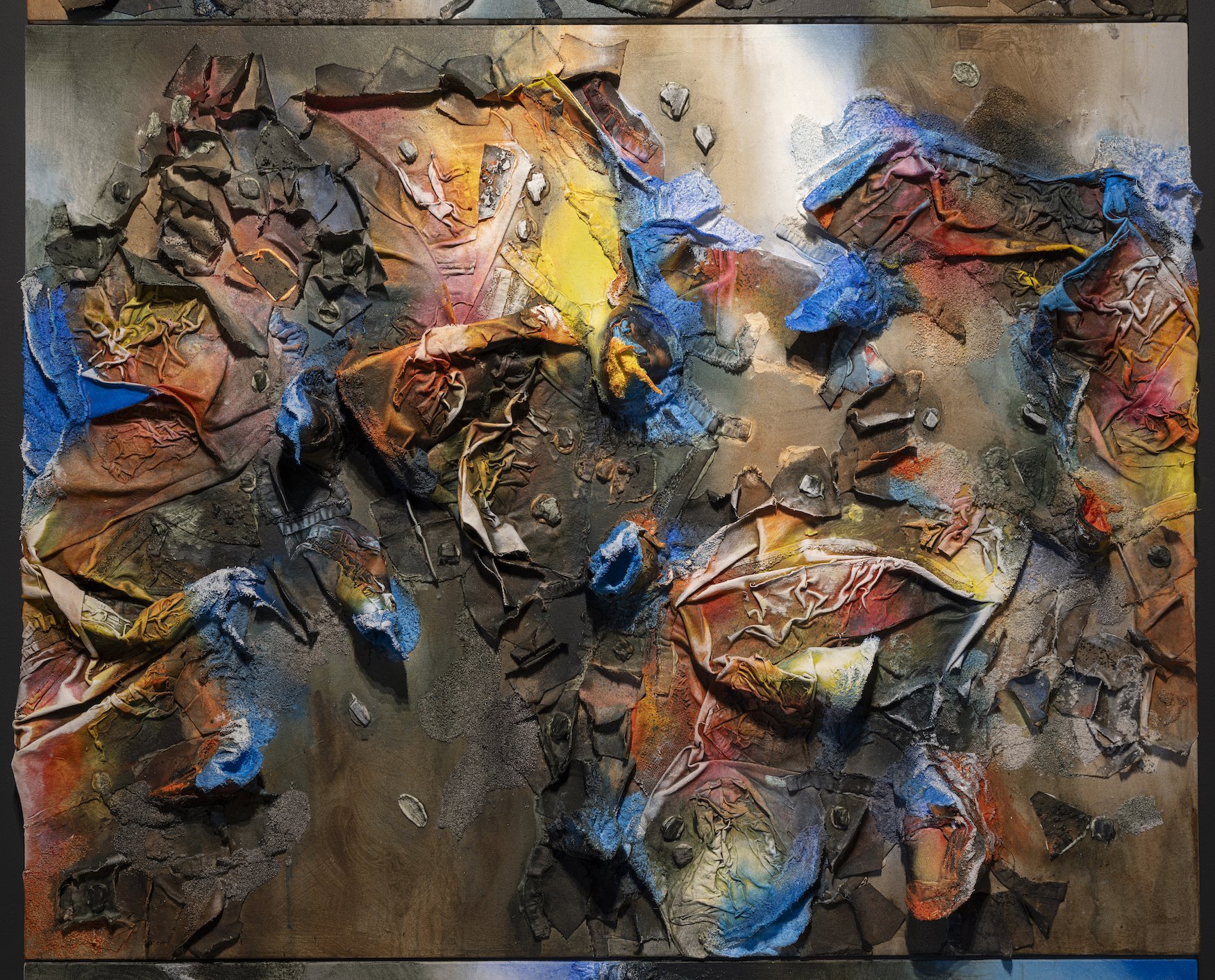Tectonic Shifts Make Way For Hope In Leslie Martinez’s Paintings
Leslie Martinez’s largest body of work to date is on view at MoMA PS1. Gathering recent paintings and three newly commissioned, large-scale works, The Fault of Formation proves critical and timely in its proposal, providing a space to feel the discomfort and hope that can arise when living socially and geographically outside the mainstream of American society and politics.
The artworks radiate a CMYK palette. Full of opacities and transparencies that seep past each other, the works create openings and closings that resemble the breakdown of colors and wonder found in deep space; all the while, Martinez’s use of textures, shaped by spare canvas and used rags, keeps us grounded on Earth with notions of resourcefulness in the face of adversities. Their paintings embody the connection they see between the survival skills and ancestral knowledge inherited from living in the borderlands of the Rio Grande Valley and José Esteban Muñoz’s theory of a queer utopia, where queerness offers itself a state of potentiality and an unpromised horizon yet to be reached. In collaboration with the curator, Elena Ketelsen González, the exhibition became an opportunity for new gestures, including a singular piece that “bends” across two walls in the last room.
After attending a panel discussion between Martinez and writer and educator Raquel Gutiérrez, author of Brown Neon, I had the chance to follow up on shared thoughts and talk more with the artist about their work.
Intervenxions edited the following interview for brevity and clarity.
Sebastián Meltz-Collazo: First, could you talk about how you saw elements of Rasquachismo at play in your own experiences and the lives of others? And what do you think of the transference of that essence onto your paintings?
Leslie Martinez: Growing up, it was evident how things were being used or reused, repurposed or saved, and decorated in and outside the home. But it was mostly regarding tools and space, how space was delineated, and how people fenced things in or made their own comfortable space. Most structures around me would be made up of discarded construction materials—repurposing rocks, cement, and all kinds of stuff to make places, plant things, shape gardens, or fences.
From my experiences, all sorts of things in the Rio Grande Valley pop up. It’s funny because I don't really think about it so much as what specific objects influenced me. It's more my relationship to this understanding of a will to create things in public or civic spaces from what was available. All the parks where I grew up were made by hand. People laid bricks, and they’d use very simple metal tubing and wooden planks to make picnic benches, seesaws, and swing sets. The people who lived here couldn't wait for somebody else to build what they needed to develop their public and private spaces. I think some aspects of this show up in architectural color, and the slight wonky look of how things are built, like storage buildings, houses, or even City Hall. They're very simple structures––very, very crude. So just cement, brick, and rusty pipes.
My grandfather also had coffee cans full of cement to use as pulleys for a kind of resistance weightlifting system, along with barbells made out of coffee cans and concrete. He also made things to make farming or ranching possible without proper tools. I mean, there are just so many ways to count. I think I apply the softer version of that with materials like fabrics and paint.
“The people who lived here couldn’t wait for somebody else to build what they needed to develop their public and private spaces.”
SMC: Why do you find it essential to include those rags and scraps on the canvas? You once shared that you “want the piece to be everything it takes to make itself.” Why is it essential for it to be that way?
LM: Because it’s self-fulfilling, these materials cannot be held up at a port of entry; they're abundant. They'll never come across a supply chain issue or prohibitions. Its abundance in the world guarantees that regardless of economics or anything like that, I can do my work. And it's also about the way the materials just move and hold shape. So it's a sort of re-visioning of what paint can be through another malleable form. It's very much about not being able to run low on these. And at times, they’re free, or at least they can be.
Another aspect of it, besides being simply resourceful, is that it holds time in record, similar to how human memories hold our histories. It's a way of replicating this idea of continuity or a lineage of my studio practice. Through an attachment to the materials and the process of transforming them, there's this very human element that is a lot like the blood that runs through your veins. I'm fascinated by the transformation of these materials over time because it happens alongside life itself. It's like how we are all sort of products of our environment. I'm trying to create an aesthetic or a methodology in the studio that does the same thing but doesn't negatively impact the environment.
SMC: The Fault of Formation includes works that reference the Earth's fault lines being dueling forces that give rise to mountains. How did you arrive at this title and the ideas around the Earth's shifting tectonic plates?
LM: To me, it is a political idea in terms of the ways that we have been pushed and siloed into different poles. It's something I've been interested in my whole life: political polarization and the increasing nature of that, and how if you're a person who is caught in those fault lines on various fronts—those being geographical, political, legal, racial, ethnic, and gender-wise—then you’re cast aside. There’s no room for possibility. If you're not a person who can easily subscribe to very fixed identities, then, in that tension between these two places where you just don't fit, you and I can find a way to carve out a new idea for living, for surviving. So I consider myself to be a person who occupies this other space. I am in this show and with the title, I want to think about the possibility for a better, more sensical future that's not yet here but can be.
“If you’re a person who is caught in those fault lines on various fronts—those being geographical, political, legal, racial, ethnic, and gender-wise—then you’re cast aside.”
SMC: Something you expressed during the panel discussion in November 2023 stuck with me. You said, “It's a space where your spirit is never at rest because society's telling you that you have to be destroyed.”
LM: One of the main things was the never-ending anti-trans, anti-immigrant rhetoric that is pushing a lot of people toward adopting very violent and destructive belief systems. I was just taken aback by how insane it is to attack such a small group of people who don't have a ton of political power at all in this country. And the sort of delusion that we are somehow taking over the world is so insane to me. I was thinking a lot about the violence of denying people their autonomy and freedom.
SMC: In a recorded conversation with the curator, Elena Ketelsen, you mentioned that you like to watch Selena’s last concert to re-center yourself; that this lets you remember your childhood self and how it ties with the advice your parents gave you: “Always give your best.” Over the last month, I have been reading a lot about Eros and how that operates within artists' work, as this vitality and driving force inside us all. I have a quote here by Audre Lorde that will lead to my next question: “The erotic is a measure between the beginnings of our sense of self and the chaos of our strongest feelings. It is an internal sense of satisfaction to which, once we have experienced it, we know we can aspire to… It is not a question only of what we do. It is a question of how acutely and fully we can feel and the doing.”
How do you see this vitality manifesting when you give in to that moment while watching the Selena concert?
LM: There's a certain kind of rage inside. It's like this level of joy that cannot be separated from rage, which comes from the denial of that joy. It's this energy that goes right to the center. And it has to do with my understanding of that concert. What is so special and more critical about it is that you can watch it with this extreme sense of consciousness that she completely gave it her all without [her] knowing that she was about to die. And you can just see her level of intensity from knowing—I'm sure she knew by the time she started that concert that she had broken the attendance record!
When I watch that concert, I think about what could have happened if she hadn't died, with our society and the way that we treat and see Latinx folks, Mexican folks, and people of other diasporas. She was a person who could, and did, bring everybody together. Her fans were from all cultures, countries, and origins. There's a definite energy transfer when I'm watching it. I feel this anger about what has been the historical treatment of people, what my family has experienced, thinking about these intense forms of injustice regarding economic and political oppression and repression.
So I center myself. And I've been watching it since grad school. It works a lot for me. It’s almost as if someone is sending a message from another world or something. It's very empowering and invigorating. And it’s about tapping into that sort of “Now it's time to show 'em” type of attitude. I can't describe it any other way, but it comes from a deep shame that was put upon me when I was growing up in Texas.
I grew up in these two places, of course, at the border and in the Dallas, Texas, area, where there was apparent discriminatory treatment toward Latinx kids and Latinx students. And this traumatizes you into an assimilationist, protective mindset. When I listen to that concert, there's like a subversive form of radicalism in the way that she's presenting the concert, the way that she begins it with that disco medley that's like a bibliographical tribute to her influences. It isn’t just pure joy. It's a moment of transforming anger into something else that's vital, profound, ancestral. That music is cited in a particularity of place and time, and it remains timeless. It's this resource to go back to that rewinds me to that initial desire to be an artist in the world, wanting to do this sort of magical work.
The Fault of Formation is on view at MoMA PS1 (22-25 Jackson Ave., Queens, NY, 11101) until April 8, 2024.
Sebastián Meltz-Collazo is a writer, visual artist, and musician working towards new experiences through the intersection of narratives. Connecting personal with collective histories, he explores iterations of visual culture and representation, intending to raise questions about identity and its various manifestations. He is an Image Text Ithaca graduate based in New York & Puerto Rico.

